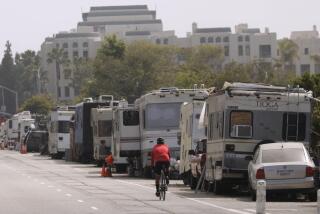City Council May Curb Catering Trucks
- Share via
After working 20 years as a cook at a Sunset Boulevard restaurant, Juan Saenz opened a place of his own four months ago.
He calls it La Jerezana , after his hometown in Mexico. His wife, Maria, works the grill, and his son, Humberto Pichardo, helps with customers. The tacos, they say, are out of this world.
“It is nice to have my own business,” Saenz said last month, his unshaven face flashing a proud smile. “We are making an honest living.”
But not everyone is pleased with Saenz’s new-found entrepreneurship. La Jerezana is a restaurant on wheels, a 22-foot-long modified Chevrolet Step Van that dishes up breakfast and lunch to gardeners, swimming pool cleaners, painters and repairmen in affluent Brentwood neighborhoods.
Some residents in those neighborhoods don’t think much of the fast-food road shows. Along Kenter Avenue, where Saenz and other caterers set up shop every day, homeowners want them out.
“I can’t even get out of my driveway,” said Nancy Real, a resident on Kenter, which is often cluttered with pick-up trucks and vans as workers pull over for a bite to eat. “I have a little boy I take to school, and twice we have almost been hit by cars.”
Complaints from Brentwood residents, coupled with other gripes about trucks in Cypress Park and Wilmington, have led to new calls at Los Angeles City Hall for stiffer regulations on the rolling restaurants, which have become a roadside institution in many parts of the city.
The Los Angeles City Council is expected to consider a proposed ordinance this month that would limit stops by catering trucks to half an hour. Other proposals being considered by the council would ban the trucks from residential streets and sharply increase fines for violations.
“The thrust of this is to allow the industry to continue but to regulate it in a meaningful way,” said Councilman Marvin Braude, who proposed the half-hour limit.
Councilman Nate Holden, who heads the council’s transportation committee, said the trucks have assumed a role far larger than city officials envisioned when they last imposed regulations more than a decade ago.
“They were intended to go visit construction sites,” Holden said.
But drivers of catering trucks say times have changed. Southern Californians value convenience, they say, and that extends beyond the construction and factory workers looking for a cold soda during a break. As a result, the area has grown into the catering truck capital of the country, with 5,000 trucks licensed in Los Angeles County alone.
Some of the drivers say they would be forced out of business if the city imposed new restrictions on their hours because they depend on one stop for their livelihood. La Jerezana , as an example, typically spends five to six hours a day at the same spot on Kenter. “I don’t think we could survive too good,” Pichardo said of the proposed restrictions.
In Wilmington, Sabado Ramirez expressed similar gloom. Ramirez began operating his own truck this month on Blinn Avenue after working 10 years on his uncle’s catering truck in the San Fernando Valley.
“I would have to go to factories looking for people who want lunch,” said Ramirez, a native of Mexico City. “But that is real hard. There are a lot of catering trucks.”
On Wednesday, about 50 trucks circled Los Angeles City Hall and several dozen drivers and family members marched on the sidewalk outside the Spring Street entrance to protest the proposed restrictions. The picketers said they belong to the Independent Catering Truck Owners Assn., a month-old group of 300 drivers who do not work for large catering companies.
Tony Sosa, a driver from East Los Angeles and president of the group, said the large catering companies control most traditional routes at factories and office buildings, forcing independent drivers to look for business on the streets.
“We need to stay five or six hours at one location to make a living,” Sosa said. “Some of us park near hospitals where there are different break times. You can’t just park there for a half hour and move on. You would miss most of your customers.”
Kelly Ramirez, executive director of Industrial Caterers Assn., said his organization is also concerned about the proposed restrictions and will attempt to work with the city over the next month to soften them. The group, which represents large catering companies, accounts for about half of the catering trucks licensed by the Los Angeles County Department of Health Services.
“I think the Los Angeles Police Department has a lot better things to do than go around and bother caterers who are trying to feed people,” said Kelly Ramirez.
One driver in Wilmington said he feared the new regulations are racially motivated, a charge city officials deny. “A lot of people don’t like Hispanic people,” said Pablo Vargas, who has parked his truck for two years on Blinn. “They don’t like us working here.”
The protesters outside City Hall on Wednesday--almost all of whom were Latino--also said the new restrictions would be discriminatory. Several carried placards proclaiming, “Do Not Violate our Civil Rights” and “Discrimination Against Hispanics.”
“We want to better ourselves,” Sosa said. “But it seems they want to keep us down.” About 90% of those in the catering truck industry in Los Angeles are Latino, according to the Industrial Caterers Assn. The group estimates that the industry employs 8,000 Latinos, most of whom frequent construction sites and factories.
Councilwoman Gloria Molina said at a recent council meeting that it is important the city craft a “balanced law” that does not hurt operators who are not causing problems. “Let’s get those that have been abusing a privilege they’ve had for a long time,” Molina said.
Catering trucks in the city of Los Angeles already fall under a series of regulations, including requirements that they not park within 100 feet of intersections or restaurant entrances, or within 200 feet of schools or freeway ramps. Sales are also restricted to the vehicle’s curbside, and each truck is required to provide a trash can.
The city attempted to impose tougher requirements in the 1970s, at one point limiting curbside sales to 10 minutes. But catering truck drivers successfully challenged the restrictions in court, and later, Mayor Tom Bradley vetoed an ordinance that he said was too restrictive. Bradley has not announced a position on the current proposals.
This time, however, Braude said his office has carefully researched the issue in hopes of avoiding the pitfalls of the past. The 10-minute restriction was struck down in 1975 because it did not specify how far a truck must move after the period has elapsed. In his current proposal, Braude has suggested that the truck be required to move at least half a mile after a half-hour stop.
Henry Morris, deputy city attorney, said the state Motor Vehicle Code authorizes the city to impose restrictions on catering trucks so long as they are based on public safety concerns. It will not be difficult to meet such a test with the proposed new regulations, he said, because many trucks pose potential hazards for pedestrians and motorists.
“This is particularly true around peak times, such as breaks or lunch,” Morris said. “You have a lot of people for whatever reason (who) are pressed for time, and they need to move. . . . An individual could be forced, perhaps due to the density of the crowd, to traverse the roadway. Any time you have that kind of situation, you have potential for hazard to people.”
Other cities in the Los Angeles area already impose tough restrictions on catering trucks, with Glendale’s 4-year-old ordinance regarded as one of the most restrictive. Trucks in that city can park on public streets for just 10 minutes unless they receive a special city permit. City Clerk Aileen Boyle said only five of the 100 catering trucks there have been given extensions, ranging from one hour to four hours.
The Glendale law, like the proposed Los Angeles restrictions, does not deal directly with trucks that park on private property. Glendale and Los Angeles officials said other city ordinances, such as building and zoning codes, already restrict food sales on private property.
In the city of Los Angeles, problems with the trucks are as diverse as the communities they serve. In Cypress Park and other parts of northeast Los Angeles, residents don’t worry about gardeners blocking their driveways. They say they are concerned about crime.
Some trucks have become hazards in those areas because of the rowdy crowds they attract, city officials said. Shortly after 6 p.m., the trucks line up outside liquor stores and bars, often becoming a gathering place for “riffraff,” as one city official said. Many trucks remain in one place for six to eight hours, officials said.
“The trucks are a real nuisance to neighborhoods,” said Molina, who had bottles tossed at her recently when she asked a driver on Figueroa Street near Avenue 43 to move his truck. “In our neighborhood it creates public drinking. With the taco or whatever they are purchasing, they also have their beer they bought at the liquor store. We have to eliminate it.”
Some catering truck operators, however, complain that the city is going after the wrong guy. “We don’t sell the alcohol,” said Jose Luis Martinez, speaking from his truck outside the Figueroa Market in Cypress Park.
Problems with catering trucks on L Street near Avalon Boulevard in Wilmington led to a city experiment several months ago that harbor-area Councilwoman Joan Milke Flores said has flopped. City officials posted “No Parking” signs along a stretch of L Street, eliminating the catering trucks but also wiping out valuable curbside parking for visitors at a nearby senior citizens center.
Flores has proposed an alternate pilot program for Wilmington that would keep catering trucks off public streets by restricting them to construction and industrial sites. In addition, parking would be limited to one hour on streets where catering trucks have been a problem.
More to Read
Sign up for Essential California
The most important California stories and recommendations in your inbox every morning.
You may occasionally receive promotional content from the Los Angeles Times.













